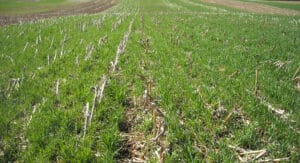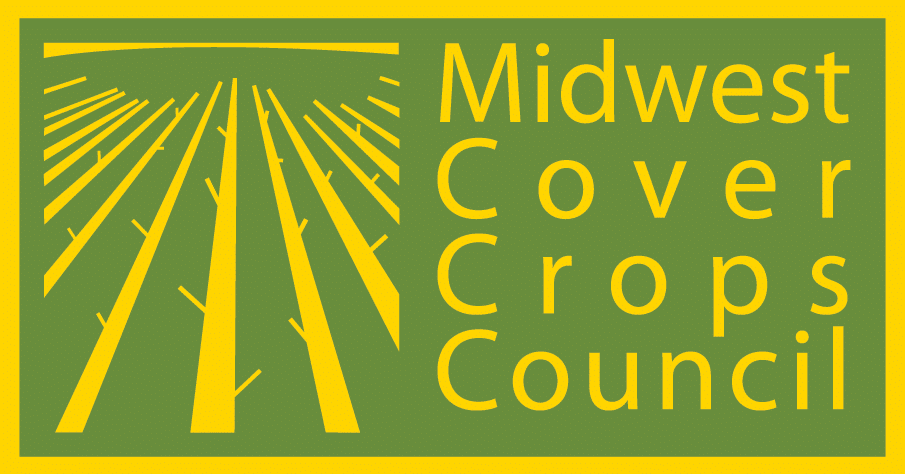Midwest Cover Crops Council (MCCC-109)
Michigan State Extension (CC-03)
This publication is intended to provide a starting point for farmers who are new to growing cover crops. With experience, farmers may fine-tune the use of cover crops for their systems.
Introduction
This recipe provides an introductory approach to integrating a cover crop into a corn-soybean rotation. Planting a cereal rye cover crop ahead of soybean is a way to introduce cover crops into your rotation. (Note: Cereal rye [Secale cereale] and annual ryegrass [Lolium multiflorum] are different species and are not interchangeable.)
Planning and Preparation
- Planning—Educate yourself. Start small. Be timely. Prioritize management based on your purpose and objectives.
- Corn hybrid and planting—If possible, plant the preceding corn crop early and use an early maturity hybrid. One strategy is to use cover crops on the field you usually harvest first, on sloping ground, or on a field where you can watch it regularly.
- Residual corn herbicides—Cereal rye can be seeded and successfully established in the fall following most spring-applied residuals used in corn. However, if cereal rye will be grazed or fed to livestock, check restrictions. See Weed Control Guide for Field Crops for more details.
- Natural Resources Conservation Service (NRCS) programs—Cover crops enrolled in the Conservation Stewardship Program (CSP) or Environmental Quality Incentives Program (EQIP) cannot be used for dual-purpose grazing.
- Seed purchase—Order cereal rye seed early. Named varieties generally perform more predictably and can produce substantially more growth than variety not stated (VNS) seed but are more expensive. VNS seed should be purchased from a reputable dealer, be cleaned, tested for germination, and have a seed tag.
Fall Work
- Corn harvest—Harvest fields where cereal rye is to be planted as early as possible.
- Tillage or no-tillage—To allow for adequate cover crop growth, it is best if no full-width tillage is planned after planting and before termination. If tillage is used, it is better to wait until spring in order to maintain surface cover to prevent erosion.
- Timing of planting—Ideally, plant cereal rye as soon after harvest as possible and no later than one week after the 50% frost date. On average, plant before these dates: Upper Peninsula, Oct. 11; northern Lower Peninsula, Oct. 15; central Lower Peninsula, Oct. 25; and southern Lower Peninsula, Oct. 28. Use the Cover Crop Selector Tool for more precise seeding dates for your county. Proximity to the Great Lakes and latitude influence these dates.
- Planting method—Drill to 0.75–1.50 inches deep or broad-cast with shallow incorporation. Good seed-soil contact will ensure a more reliable stand. See Recommended Cover Crop Seeding Methods and Tools.
- Seeding rate—Drilled: 45–60 lbs./acre. Broadcast with shallow incorporation: 50–65 lbs./acre. These rates are based on high-quality seed with 85–98% germination.
- Fertility or liming—If applying P, K, lime, or manure, complete the application and incorporation prior to seeding or apply to growing rye before the ground freezes. If injecting manure, low-disturbance injectors are available that will minimize damage to the cereal rye. Surface application of liquid manure on top of the rye is not recommended. Surface broadcast of dry manure should be done prior to seeding, but 4 tons or less can be applied to growing cereal rye with minimal damage provided it is evenly distributed.
Spring Work
- Scouting—In the spring, scout your cover crop to determine growth and coverage. If rainfall is below normal, monitor soil moisture in case earlier termination is needed.
- Termination timing—Cereal rye usually grows rapidly in the spring, so have a termination plan ready. Terminate when plants are 6 to 12 inches tall and actively growing or about two weeks before planting soybean—whichever comes first. Many growers successfully plant soybean into terminated cereal rye taller than 12 inches, but new users should terminate when cereal rye is smaller (Figure 1). See Michigan State University Extension (MSUE) publication CC-01 in the Resources section for more information.

height (shown here). (Eileen Kladivko)
- Termination by herbicide—Cereal rye can easily be terminated with full-rate glyphosate (minimum of 1 lb. acid equivalent [ae]/acre) after dormancy breaks. To maximize the effectiveness of glyphosate and minimize time for complete control, apply when rye is actively growing and temperatures favor growth. Larger rye, rye past the boot stage, or rye sprayed during cooler weather can be more difficult to kill or will die more slowly. Be aware that when conditions are cool and cloudy, metribuzin and saflufenacil tank mixtures with glyphosate may delay or antagonize glyphosate activity for rye termination. See MSUE Bulletin E0434 for more herbicide information.
- Termination by tillage—In systems that include tillage or are organic, tillage can be a reliable termination method. However, multiple passes may be required. See MSUE publication CC-01.
- Termination modifications for dry weather—Watch the weather and be ready to modify your plans. In a dry spring, the cereal rye can use moisture needed by the cash crop, so terminate sooner to allow rainfall to make up the deficit.
- Termination modifications for wet weather—When using herbicides to terminate cereal rye during a wet spring and under difficult conditions for spraying, be ready to use any break in the weather and/or low axle weight sprayers. If soybean planting is less than 10 days away and the rye is tall, consider planting green (i.e., terminating within a day or two of planting). It is usually better to plant either into brown, dead rye plants or into standing green plants as opposed to large, dying, yellow/green (“rubbery”) cereal rye plants that have fallen on the soil surface and formed a mat. If using tillage for termination, wait 10–14 days after rye incorporation to plant soybean to avoid seed predation from seed corn maggot.
- Soybean planting—It is usually best to no-till plant soybean into the dead/dry or standing cereal rye cover crop. Almost all modern planters and drills are fully capable of planting soybean into a cereal rye cover crop. Check planting depth and seed furrow closure shortly after beginning to plant into residue and adjust as needed.
- Scouting—After planting, scout for soybean emergence and population. Additionally, scout for weeds since substantial cereal rye residue can often delay emergence of annual weeds, which may delay the application of post-emergence herbicides.
Resources
Cover Crop Selector Tool —available from Midwest Cover Crops Council
Weed Control Guide for Field Crops (Michigan State University Extension Bulletin E0434)
Cover Crop Termination (Michigan State University Extension publication CC-01)
Recommended Cover Crop Seeding Methods and Tools (Agronomy Technical Note)— available from USDA–Natural Resources Conservation Service,
Authors
Dean Baas, MSUE; Christina Curell, MSUE; Paul Gross, MSUE; Monica Jean, MSUE; Philip Kaatz, MSUE; and Elizabeth H. Schultheis, MSU (Note: This publication was adapted with consent from MCCC under a joint project to produce customized introductory guidance about cover crops for all member states/provinces.)
Reviewers and Contributors
Jerry Grigar, USDA–NRCS Service; Erin Hill, MSU; Eileen J. Kladivko, Purdue University; Anna L. Morrow, Midwest Cover Crops Council; Sieg Snapp, MSU
The Midwest Cover Crops Council (www.https://www.midwestcovercrops.org) aims to facilitate widespread adoption of cover crops throughout the Midwest by providing educational/outreach resources and programs, conducting new research, and communicating about cover crops to the public.
Funding for this project was provided by McKnight Foundation.
August 2019
The U.S. Department of Agriculture (USDA) prohibits discrimination in all its programs and activities on the basis of race, color, national origin, age, disability, and where applicable, sex, marital status, familial status, parental status, religion, sexual orientation, genetic information, political beliefs, reprisal, or because all or a part of an individual’s income is derived from any public assistance program. (Not all prohibited bases apply to all programs.) Persons with disabilities who require alternative means for communication of program information (Braille, large print, audiotape, etc.) should contact USDA’s TARGET Center at (202) 720-2600 (voice and TDD). To file a complaint of discrimination write to USDA, Director, Office of Civil Rights, 1400 Independence Avenue, S.W., Washington, D.C. 20250-9410 or call (800) 795-3272 (voice) or (202) 720-6382 (TDD). USDA is an equal opportunity provider and employer. ©2019 by MCCC. All rights reserved.
